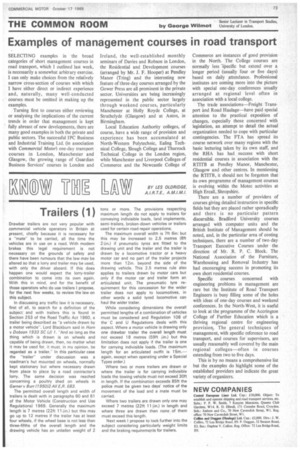Trailers (1)
Page 75

If you've noticed an error in this article please click here to report it so we can fix it.
Drawbar trailers are not very popular with commercial vehicle operators in Britain at present, chiefly because it is necessary for a "mate" to be carried, all the time the vehicles are in use on a road. With modem brakes this legal requirement is not necessary on the grounds of safety and there have been rumours that the law may be altered so that a lorry and trailer may be used. with only the driver aboard. If this does happen one would expect the lorry-trailer combination to come into its own again. With this in mind, and for the benefit of those operators who do use trailers I propose, for the next few weeks, to review the law on this subject.
In discussing any traffic law it is necessary, first of all, to search for a definition of the subject and with trailers this is found in Section 253 of the Road Traffic Act 1960, a trailer being described as "a vehicle drawn by a motor vehicle". Lord Blackburn said in Horn v Dobson 1933 SC (J)1. "And so long as the thing which is drawn is on wheels and capable of being drawn, then, no matter what it may be used for, it must, in my opinion, be regarded as a trailer." In this particular case the "trailer" under discussion was a roadman's hut mounted on wheels, normally kept stationary but where necessary drawn from place to place by a road contractor's lorry. The same decision was reached concerning a poultry shed on wheels in Garner v Burr (1950)2 All ER. 683.
The permitted overall length and width of trailers is dealt with in paragraphs 60 and 61 of the Motor Vehicle (Construction and Use Regulations) 1969. Generally the maximum length is 7 metres (2211 11 -tin.) but this may go up to 12 metres if the trailer has at least four wheels, if the wheel base is not less than three-fifths of the overall length and the drawing vehicle has an unladen weight of 2
tons or more. The provisions respecting maximum length do not apply to trailers for conveying indivisible loads, land implements, semi-trailers, broken-down vehicles or trailers used for certain road repair operations.
The maximum overall width is 7ft 61n: but this may be increased to 2.5 metres (8ft
24in.) if pneumatic tyres are fitted to the
drawing unit and the trailer and the trailer is drawn by a locomotive tractor or a heavy motor car and no part of the trailer projects more than 12in. beyond the side of the drawing vehicle. This 2.5 metres rule also applies to trailers drawn by motor cars but only if the motor car and trailer form an articulated unit. The pneumatic tyre requirement for this concession for the wider trailer does not apply to locomotives, in other words a solid tyred locomotive can haul the wider trailer.
While considering dimensions the overall permitted lengths of a combination of vehicles must be considered and Regulation 108 of the C and U Regulations deals with this aspect. Where a motor vehicle is drawing only one drawbar trailer the overall length must
not exceed 18 metres (59ft 4-in.) but this limitation does not apply if the trailer is one
for carrying indivisible loads. (The maximum length for an articulated outfit is 15m.— again, except when operating under a Special Types order.) Where two or more trailers are drawn or where the trailer is for carrying indivisible loads the towing vehicle must not exceed 30ft in length. If the combination exceeds 85ft the police must be given two days' notice of the movement of the load and a mate must be carried.
Where two trailers are drawn only one may exceed 7 metres (22ft 11 kin.) in length and where three are drawn then none of them must exceed this length.
Next week I propose to look further into the subject considering particularly weight limits and the braking requirements for trailers.
NEW COMPANIES
Central Emopeas Lima Ltd. Cap.: £30.000. Object: To establish and operate shipping and road transport services, etc. Subs.: P. P. W. Smith. 7 Kenyon Mansions, Queens Club Gardens, W14. R. D. Ellweil, 171 Coombe Road, Croydon. Sole.: kelson and Co.. 70 New Cavendish Street, WI. Reg. office: 70 New Cavendish Street, Wl.
Corm add Down (flatdage) LtdCap.: £2,000. Dirs.: J. W. Collins. '72 Lea Bridge Road. E9. P. Duggan. 32 Swaton Road. E3. Sec.: Daphne V. Collins. Reg. Office: 72 Lea Bridge Road, E9.




























































































































